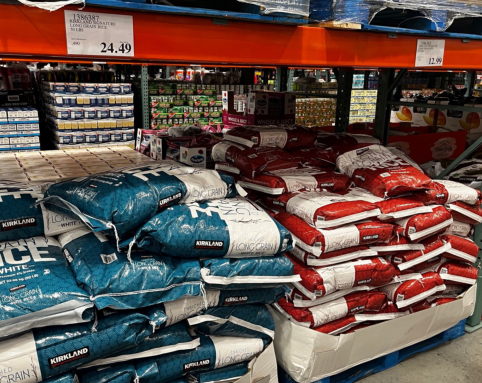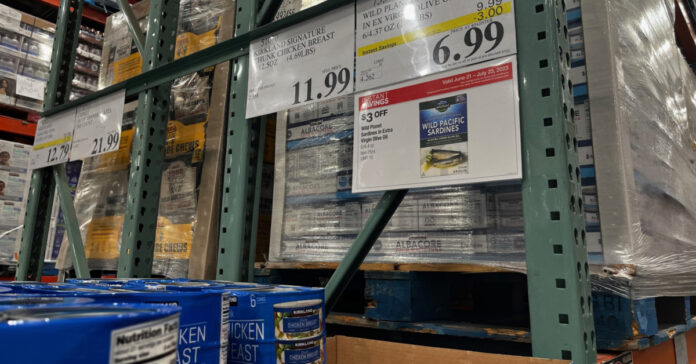While on a road trip this past week, I hit a Costco in Virginia. I don’t get to Costco very often because there are none in my immediate area.
I was shocked to see canned chicken was on sale for $11.99 for six cans. That is getting down to the pre-COVID price. (In January 2021 a six-pack was $11.59 at Costco and $9.96 at Sam’s Club.) The sale price is also about half of what it sold for during the peak of the food shortage in 2022. This is one example where inflation has retreated as inventory increased.
I bought a two-pack, or twelve cans, of the canned chicken. Of course, by the time I made it home and was unloading my haul, I wished I had purchased twice as many. Still, this helped replenish our stockpile.
Sardines were also on sale, as you can see in the main image. I’m not a huge fan of sardines, but I’ll eat them. Costco also had canned roast beef, but I passed on it. I prefer canned pork.
I recommend stocking up on canned proteins while you can. Canned chicken may be important if the bird flu returns, driving up prices again.
High Prices, Good Availability
When Costco had items for sales, their sale prices were good buys. However, the prices for items not on sale were higher than I remember, often by 20 percent or more. Prices were up for 55-gallon garbage bags, a bag of macadamia nuts, or a box of crackers, for instance. This is an example of the inflation I wrote about earlier in the week. While the rate at which inflation is growing has declined, food inflation is still running at about 7.5 percent over last year.

If you are planning on doing some pantry stacking, inventory levels at this Costco appeared adequate or better. Costo had plenty of rice, an important staple for preppers. It was also a good buy, with long grain rice at about 49 cents per pound if you bought the 50-pound bag.
There were plenty of other canned goods and baking items, including flour. Pasta and sauce were plentiful, but the buttermilk pancake mix had more than doubled January 2021, jumping from $3.50 to $7.98. Even at $7.98, it’s cheaper in the store than ordering online, and it makes lots of pancakes.
If you are like me and add canned products to your prepper pantry, don’t neglect breakfast foods. Canned meats, chili, soups, vegetables and fruits are more for dinner than breakfast, although corned beef hash can be an exception. I stock pancake mix, oatmeal, and grits. I also have some old #10 cans of granola. Bisquick and muffin mixes are also good items to stock for breakfast.
Anecdotal Evidence
I was traveling mid-week and well inland, so there was not much beach traffic. I saw a decent number of large RVs and campers, so people are going camping even though sales of these recreational vehicles have dropped off. You might consider this a good sign—people are still going on vacation. On the other hand, camping is a low-cost vacation compared to renting hotels or staying at resorts.
There were an average number of trucks on the road. In contrast to some previous trips, I saw almost no empty flatbed trucks, meaning there was lots of heavy equipment on the move and no truckers were forced to deadhead home. I also passed more wide loads than I recall on any previous trip, including one truck that had a very large tank on it.
I consider these observations to be anecdotal evidence that we are not yet heading into a recession. People are buying manufactured homes, businesses are buying mechanical equipment, trucks are delivering goods to warehouses up and down the highway. And yes, cops are padding their budgets by stopping speeders. My GPS app warned me of several speed traps, and I saw cars pulled over by troopers both on my trip there and back. Lots of undercover cop car on the highways.
A Different Kind of Stocking Up
I also stopped at a large gun store and purchased two additional magazines for my Glock 48, giving me a total of eight. Currently, I have one in the gun, a reload on me, a loaded magazine in my car and another magazine in my EDC bag. I added one of the new magazines to my vehicle survival kit. It is unloaded, but the vehicle kit has 125 9mm rounds in it, so if I need to walk home, that won’t be a problem for long. The other three magazines will be spares which I will rotate in and out of service.
I practice tactical reloads, and if I am behind cover during a lull, I would probably perform one. But if I’m in a running gunfight, I think it’s far more likely I will shoot to slide lock, eject the mag, and reload as quickly as possible. That’s why it’s important to have spare magazines back at home, so you won’t be down a mag if you never recover your spent one. This applies to rifles even more than too pistols because in a post-SHTF situation, your rifle will be your primary weapons. Having spare magazines not only allows you to compensate for those that are lost or damaged during an engagement, but you can stash loaded magazines in shooting positions or cache them in strategic locations.
The store had +2 and +4 magazine extensions, but they were for other Glock models. When I got home, I ordered a +4 extension for a Glock 48 magazine. I’ll add it to a magazine and test it with 200 rounds. If it performs flawlessly, then I will carry it as my reload, giving me 14 spare rounds instead of 10.
Wound Tight
Maybe I’m not used to people from other places, bur people seemed tense. Costco may have plenty of food, there were of trucks on the road, and ammunition has become cheaper and more plentiful again, but it feels like the country is a rubber band wound tight. No one knows how many more turns it will take before it bursts. Keep prepping. Whether you buy 12 cans of food or two, every little bit helps.







